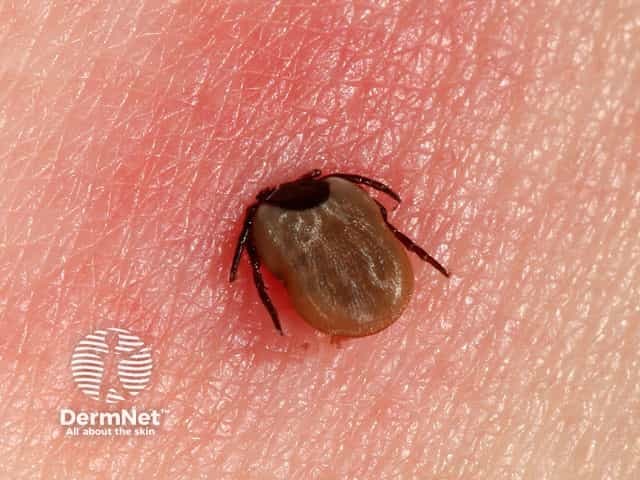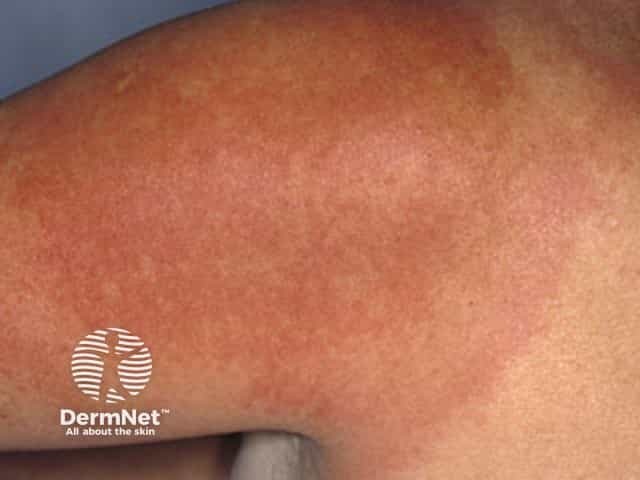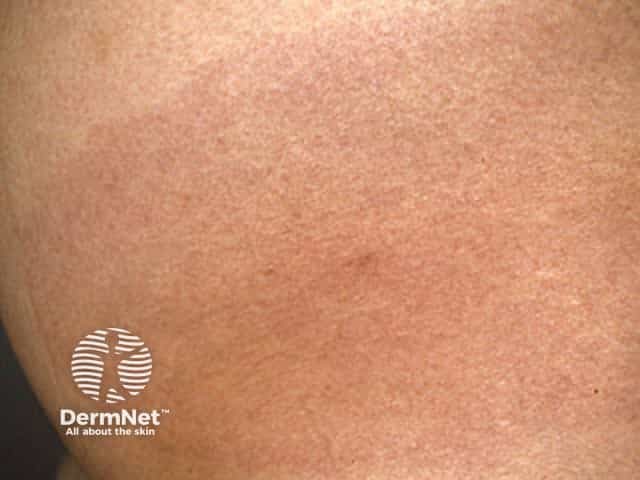Main menu
Common skin conditions

NEWS
Join DermNet PRO
Read more
Quick links
Lyme disease — extra information
Lyme disease
Author: Vanessa Ngan, Staff Writer, 2003. Updated by Dr Daniela Vanousova, Dermatologist, Czech Republic, March 2015.
Introduction
Subtypes
Cause
Demographics
After a tick bite
Clinical features
Erythema migrans
Diagnosis
Treatment
Prevention
What is Lyme disease?
Lyme disease is an infection caused by Borrelia, a type of bacteria called a spirochaete. Lyme disease can affect any part of the body, most commonly the skin, central nervous system, joints, heart, and rarely the eyes and liver.
Lyme disease is common in parts of the United States (particularly in Massachusetts) and Europe but is reported from many areas of the world. In New Zealand and Australia, cases have only been confirmed in people that have recently travelled from an endemic area.
Lyme disease is also called Lyme borreliosis.
Erythema chronicum migrans

Ixodes tick

Erythema chronicum migrans

Erythema chronicum migrans
See more images of erythema migrans.
What are the subtypes of Lyme disease?
There are different types of Borrelia in each continent resulting in various forms of Lyme disease in North America and Europe.
In North America, the infection is due to the subspecies B. burgdorferi sensu stricto and most often presents as:
- Erythema migrans (also called erythema chronica migrans)
- Lyme arthritis
In Europe, Lyme disease is due to the subspecies B. burgdorferi sensu stricto, B. afzelii and B. garinii, and most often presents as:
- Erythema migrans
- Borrelial lymphocytoma
- Acrodermatitis chronica atrophicans (this is due to B. afzelii)
- Lyme neuroborreliosis.
How do you acquire this borrelia infection?
Humans and animals are infected with the bacteria through hard-tick bites. The borrelia survive in the midgut of the ticks. The immature nymphs are most likely to transmit the infection. The ticks feed on infected animals and then on humans.
Ticks occur in high grass, brush, woodland and leafy forest. The main hosts for the ticks and borrelia are small to medium-sized animals in Europe and deer in North America.
- In North America, the tick vectors are Ixodes scapularis, I. pacificus, and 4 other tick species
- In Europe and Asia, the tick vectors are I. ricinus, I. hexagonus, and I. persulcatus
Who gets Lyme disease?
Lyme disease can affect children and adults. Infection most often occurs in forestry workers and in those who have been enjoying recreational activities in areas where ticks reside.
What happens after a tick bite?
Ticks can attach and feed in any part of the human body. The bite is painless. Because they are very tiny (just 2 mm in size) nymph bites are often overlooked. Borrelia are transmitted from the midgut of the infected tick to the attached skin when attachment lasts for 36–48 hours.
Several things can happen after being bitten by an infected tick.
- The body's defence mechanisms can overwhelm and eliminate the infecting bacteria.
- The bacteria can remain localised at the site of the bite and cause a localised skin infection.
- The bacteria may disseminate via the blood and lymphatic system to other organs and cause a multisystem inflammatory disease.
What are the signs and symptoms of Lyme disease?
The disease can be divided into three stages according to the extent of the infection.
Stage |
Features |
|
|---|---|---|
Localised Lyme disease 3–33 days after a tick bite |
|
|
Early disseminated Lyme disease Days to weeks after a tick bite |
|
|
Late Lyme disease Months to years after infection |
|
|
Erythema migrans
Erythema migrans, a red expanding patch of skin, is the most typical sign of Lyme disease and is present in 70–80% of cases. It usually appears 7–14 days (range 3–33 days) after the infected tick bite. It starts at the site of the tick bite as a red papule or macule that gradually expands. The size of the rash can reach several dozens of centimetres in diameter. A central spot surrounded by clear skin that is in turn ringed by an expanding red rash (like a bull's-eye) is the most typical appearance. Erythema migrans may also present as a uniform erythematous patch or red patch with central hardening and blistering. The redness can vary from pink to very intensive purple.
Erythema migrans is mostly asymptomatic, but can be itchy, sensitive or warm if touched. It is rarely painful. Fatigue, chills, headache, low-grade fever, muscle and joint pain, may occur briefly and then recur if the disease progresses. Lymph glands near the tick bite may be swollen.
Erythema migrans disappears spontaneouslly within 3–4 weeks. If left untreated the disease may disseminate, affect other organs, and progress to the next stage.
How is Lyme disease diagnosed?
Early diagnosis of Lyme disease is essential. Diagnosis can be made on the presence of erythema migrans and other symptoms, plus a history of or evidence of a tick bite. Laboratory tests are usually not necessary in the early stage of erythema migrans,
Undetected or ignored early symptoms may be followed by more severe symptoms weeks, months or even years after the initial infection. Certain laboratory tests are then recommended to confirm the diagnosis and should be interpreted by an expert..
- Antibody titres to B burgdorferi using enzyme-linked immunoassay (ELISA) or immunofluorescent assay.
- Positive results should be confirmed by Western immunoblot.
-
Skin biopsy: histopathology
- Erythema migrans is often non-specific
- Borrelial lymphocytoma
- Acrodermatitis chronica atrophicans
- The organism can be cultured or polymerase chain reaction (PCR) test for the organism can be done on the skin specimen.
Positive antibodies to B. burgdorferi can be in many cases detected for many years after the successful treatment.
Tick bites may transmit other infections like tick-born encephalitis, anaplasmosis and babesiosis. Co-infections should be considered if symptoms of Lyme disease are severe or prolonged, in case of high fever, and abnormal blood tests results (leucopenia, thrombocytopenia, or elevation of liver transaminases).
What treatment is available for Lyme disease?
Localised or early Lyme disease generally responds well to appropriate antibiotics. Full cure is usually achieved if the disease is diagnosed and treated promptly, but the cure rate decreases the longer treatment is delayed. The choice of antibiotic depends on bacterial sensitivity.
Antibiotics used for erythema migrans include doxycycline, amoxicillin and cefuroxime. Secondline treatments are the macrolides, azithromycin and erythromycin. Intravenous penicillin and cetriaxone are used for more advanced Lyme disease. The route of administration and the duration of the course of antibiotics depends on the stage and organ involvement. It varies between 10 and 30 days. Late stage Lyme disease, especially neuroborreliosis, should be treated with intravenous antibiotics.
Some patients have persistent or recurrent symptoms of unknown origin after apparently successful antibiotic treatment for Lyme disease. This is called post-treatment Lyme borreliosis syndrome. It is believed to be an auto-immune response. Prolonged antibiotic treatment does not improve cure rates.
Prevention of Lyme disease
- Avoid areas endemic for Lyme borreliosis.
- When walking in high grass or woodland, wear white clothes (so the tick can be seen more easily) with long sleeves, long trousers tucked into socks, or long boots.
- Use repellents/pesticides.
- After return from a walk in an endemic area, change your clothes and check your whole body carefully.
- The next day, check your body for ticks again.
- Remove the tick as a prompt removal decreases the risk of Lyme disease transmission. Disinfect the site. Use tweezers to carefully and steadily pull the tick out from the skin. Disinfect the site again. Wash your hands.
- Watch the site of the tick bite for several weeks. If a rash appears bigger than 5 cm or you have 'flu-like symptoms, consult your doctor.
There is no vaccine for Lyme disease.
References
- Steere AC, Strle F, Wormser GP, et al. Lyme borreliosis [published correction appears in Nat Rev Dis Primers. 2017 Aug 03;3:17062]. Nat Rev Dis Primers. 2016;2:16090. Journal doi:10.1038/nrdp.2016.90
- Textbook of Dermatology. Ed Rook A, Wilkinson DS, Ebling FJB, Champion RH, Burton JL. Fourth edition. Blackwell Scientific Publications.
- Gary P. Wormser, Raymond J. Dattwyler, Eugene D. Shapiro, John J. Halperin, Allen C. Steere, Mark S. Klempner, Peter J. Krause, Johan S. Bakken, Franc Strle, Gerold Stanek, Linda Bockenstedt, Durland Fish, J. Stephen Dumler, Robert B. Nadelman; The Clinical Assessment, Treatment, and Prevention of Lyme Disease, Human Granulocytic Anaplasmosis, and Babesiosis: Clinical Practice Guidelines by the Infectious Diseases Society of America. Clin Infect Dis 2006; 43 (9): 1089-1134. doi: 10.1086/508667. Journal
On DermNet
- Lyme disease – Pathology
- Erythema migrans case 1
- Images of erythema chronicum migrans
- Acrodermatitis chronica atrophicans
Other tick-borne infections
- Tick-borne relapsing fever
- Tularaemia
- Babesiosis
- Rocky Mountain spotted fever
- Ehrlichiosis and anaplasmosis
Other websites
- Lyme Disease — CDC
- Tick Bites — Medline Plus
- American Lyme Disease Foundation, Inc
- Lyme Disease — Medscape Reference
